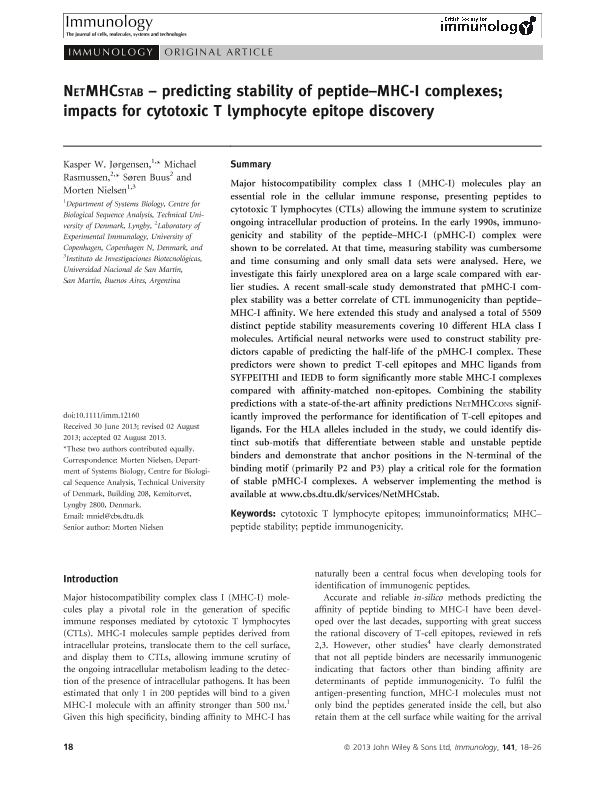Mostrar el registro sencillo del ítem
dc.contributor.author
Jørgensen, Kasper W.

dc.contributor.author
Rasmussen, Michael

dc.contributor.author
Buus, Søren

dc.contributor.author
Nielsen, Morten

dc.date.available
2017-06-09T21:28:33Z
dc.date.issued
2014-01
dc.identifier.citation
Jørgensen, Kasper W.; Rasmussen, Michael; Buus, Søren; Nielsen, Morten; NetMHCstab – predicting stability of peptide–MHC-I complexes; impacts for cytotoxic T lymphocyte epitope discovery; Wiley; Immunology; 14; 1; 1-2014; 18-26
dc.identifier.issn
0019-2805
dc.identifier.uri
http://hdl.handle.net/11336/17953
dc.description.abstract
Major histocompatibility complex class I (MHC-I) molecules play an essential role in the cellular immune response, presenting peptides to cytotoxic T lymphocytes (CTLs) allowing the immune system to scrutinize ongoing intracellular production of proteins. In the early 1990s, immunogenicity and stability of the peptide–MHC-I (pMHC-I) complex were shown to be correlated. At that time, measuring stability was cumbersome and time consuming and only small data sets were analysed. Here, we investigate this fairly unexplored area on a large scale compared with earlier studies. A recent small-scale study demonstrated that pMHC-I complex stability was a better correlate of CTL immunogenicity than peptide–MHC-I affinity. We here extended this study and analysed a total of 5509 distinct peptide stability measurements covering 10 different HLA class I molecules. Artificial neural networks were used to construct stability predictors capable of predicting the half-life of the pMHC-I complex. These predictors were shown to predict T-cell epitopes and MHC ligands from SYFPEITHI and IEDB to form significantly more stable MHC-I complexes compared with affinity-matched non-epitopes. Combining the stability predictions with a state-of-the-art affinity predictions NetMHCcons significantly improved the performance for identification of T-cell epitopes and ligands. For the HLA alleles included in the study, we could identify distinct sub-motifs that differentiate between stable and unstable peptide binders and demonstrate that anchor positions in the N-terminal of the binding motif (primarily P2 and P3) play a critical role for the formation of stable pMHC-I complexes. A webserver implementing the method is available at www.cbs.dtu.dk/services/NetMHCstab.
dc.format
application/pdf
dc.language.iso
eng
dc.publisher
Wiley

dc.rights
info:eu-repo/semantics/openAccess
dc.rights.uri
https://creativecommons.org/licenses/by-nc-sa/2.5/ar/
dc.subject
Mhc-Peptide Stability
dc.subject
Cytotoxic T Lymphocyte Epitopes
dc.subject
Immunoinformatics;
dc.subject
Peptide Immunogenicity
dc.subject.classification
Otras Ciencias de la Salud

dc.subject.classification
Ciencias de la Salud

dc.subject.classification
CIENCIAS MÉDICAS Y DE LA SALUD

dc.title
NetMHCstab – predicting stability of peptide–MHC-I complexes; impacts for cytotoxic T lymphocyte epitope discovery
dc.type
info:eu-repo/semantics/article
dc.type
info:ar-repo/semantics/artículo
dc.type
info:eu-repo/semantics/publishedVersion
dc.date.updated
2017-06-09T15:00:55Z
dc.journal.volume
14
dc.journal.number
1
dc.journal.pagination
18-26
dc.journal.pais
Estados Unidos

dc.journal.ciudad
Hoboken
dc.description.fil
Fil: Jørgensen, Kasper W.. Technical University of Denmark; Dinamarca
dc.description.fil
Fil: Rasmussen, Michael. Universidad de Copenhagen; Dinamarca
dc.description.fil
Fil: Buus, Søren. Universidad de Copenhagen; Dinamarca
dc.description.fil
Fil: Nielsen, Morten. Technical University of Denmark; Dinamarca. Consejo Nacional de Investigaciones Científicas y Técnicas. Centro Científico Tecnológico Conicet - La Plata. Instituto de Investigaciones Biotecnológicas. Universidad Nacional de San Martín. Instituto de Investigaciones Biotecnológicas; Argentina
dc.journal.title
Immunology

dc.relation.alternativeid
info:eu-repo/semantics/altIdentifier/url/http://onlinelibrary.wiley.com/doi/10.1111/imm.12160/abstract
dc.relation.alternativeid
info:eu-repo/semantics/altIdentifier/doi/http://dx.doi.org/10.1111/imm.12160
Archivos asociados
